Nestled in the heart of Vienna, Hofburg Palace stands as a monumental testament to the opulence, power, and art that has shaped European history over the centuries. This iconic palace, with its sprawling complex of buildings, gardens, and courtyards, has been the epicenter of Austrian political and social life since its inception in the 13th century. Today, it not only serves as a residence for the Austrian President but also as a beacon for culture enthusiasts from around the globe, eager to explore its rich heritage.
Note: This article contains affiliate links. In case you purchase something through one of these links, we may receive a small commission at no extra cost for you. Thank you for helping us keep creating the free content on this website!
Brief History of Hofburg Palace
The Hofburg Imperial Palace, with its name meaning "Castle of the Court," traces its origins back to the Middle Ages, signaling its longstanding significance. Its initial conception in the 13th century marked the beginning of what would become the prestigious seat of the Dukes of Austria. Construction began around 1275 during King Ottokar Przemysl's reign, initially serving as a fortified castle. This structure was destined to become the heart of the Habsburg dynasty's power, serving as the residence of the Habsburg kings and emperors of the Holy Roman Empire from 1438 to 1583 and again from 1612 to 1806.
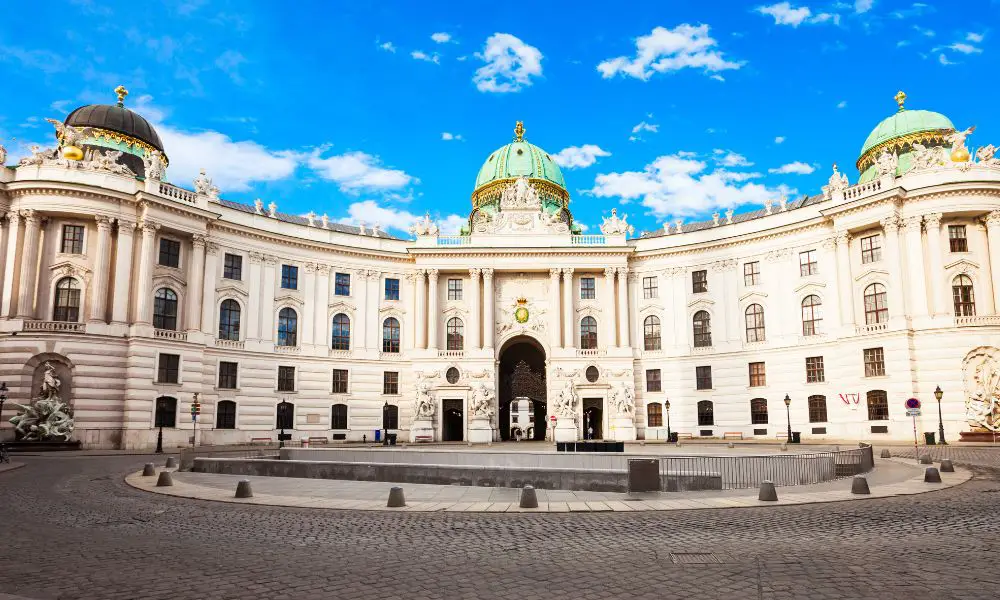
The palace underwent significant expansions and renovations, particularly in 1533 and the years following, as successive Habsburg generations added to the complex, echoing the expansion they also carried out with Schönbrunn Palace. Following their victory over the Ottomans in 1683, the Habsburgs transformed the once fortress-like exterior into a grand baroque edifice, showcasing their wealth and power.
Today, the Hofburg Imperial Palace stands as a monumental complex covering over 240,000 square meters, featuring 18 wings, 19 courtyards, and more than 2,600 rooms. It remained the imperial residence and governmental seat of the Habsburg emperors until 1918. Since the end of the Habsburg monarchy, the palace has adapted to modern times but continues to play a crucial role in Austria's political landscape as the seat of the Austrian Federal President, bridging centuries of history with contemporary state functions.
The Parts of the Hofburg Palace Complex
Walking through the gates of Hofburg Palace is like stepping into a living museum of architectural evolution. From Gothic, Renaissance, Baroque, to Rococo and Classicism, every corner of the palace tells a story of stylistic transformation, reflecting the artistic and political zeitgeist of its era. The palace's grand facade, intricate interiors, and expansive squares speak volumes about the architectural ingenuity that has gone into its centuries-long development.
Originally a medieval fortified castle dating from the 13th century, the Hofburg was extended by each emperor. The sprawling, asymmetric complex which extends over 240,000 m² consists of 18 wings, 19 courtyards and 2,600 rooms in which nearly 5,000 people still work and live today.
The Swiss Wing
Nestled within the heart of the Hobsburg Palace structures lies its most ancient quarter, affectionately dubbed the 'Swiss Wing.' This segment earned its name from its historical role as a sentinel tower, manned by vigilant guards hailing from Switzerland.
Tracing its roots back to the 13th century, the most venerable segments of this palace were either the handiwork of the Babenberg dynasty's final scion or Ottakar II from the lands of Bohemia. Before this, the Austrian sovereigns' domicile stood proudly at "Am Hof," a stone's throw away from the Schottenstift, also known as the Scottish Abbey.
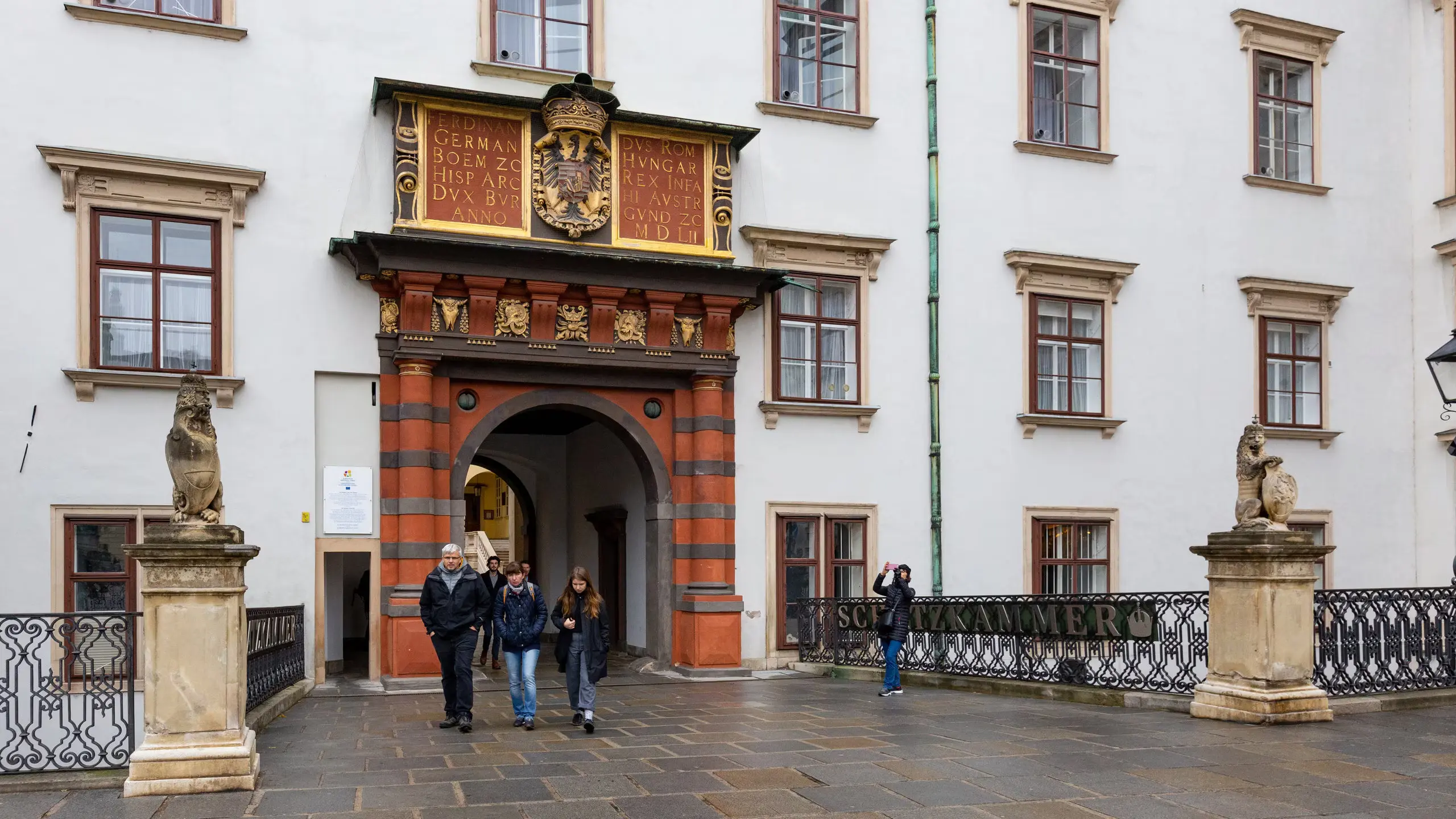
Originally designed as a fortress with a quadrilateral layout, it boasted four watchtowers and was encircled by a moat, its entrance guarded by a drawbridge. Presently, these sections amalgamate to form the Swiss Court (Schweizerhof), home to a gothic chapel (Burgkapelle) dating back to the 15th century, and a treasure trove (or Schatzkammer) under the aegis of the Kunsthistorisches Museum. This museum safeguards, among other precious items, the imperial regalia of the Holy Roman Empire (Reichskleinodien) and that of the Austrian Empire.
The Swiss Court's present-day guise harks back to the Renaissance era, under Emperor Ferdinand I's auspices. The Swiss Gate (Schweizertor) showcases Ferdinand I's myriad titles and the Order of the Golden Fleece's insignia, resplendently painted across the ceiling.
In the grandeur of the Knight's Hall (Rittersaal), on the 15th of May, 1717, Empress Maria Theresa's baptism was solemnized. The ceremony, officiated by papal nuncio Giorgio Spinola as Pope Clement XI's envoy, was distinguished by the use of baptismal water, subtly infused with droplets from the River Jordan.
Amalienburg
Nestled in the heart of history, the Hofburg Palace complex whispers tales of epochs past, with each edifice narrating its unique saga. Among its storied structures stands the Amalienburg, a gem within the Burgplatz quartet, erected in the 16th century and christened in honor of Empress Amalie Wilhelmine von Habsburg. Mourning the loss of her spouse, Joseph I, in 1711, she found solace within its walls. The Amalienburg's façade harbors curiosities—two timekeepers, one a mechanical marvel from the latter 17th century, and alongside, a sundial, its origins tracing back to the same era.
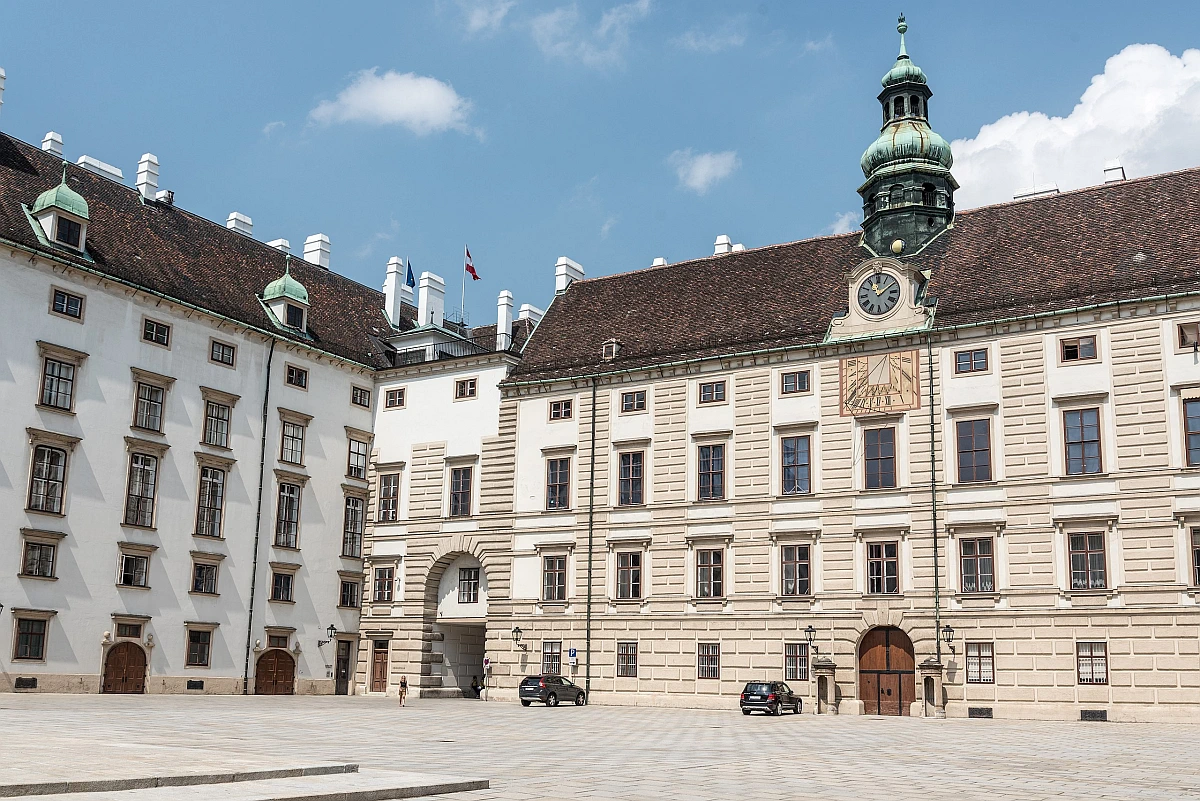
The origins and tales of these timepieces are shrouded in mystery. The sundial, a masterpiece crafted by the court's mathematician Johann Ulrich Harvolck, bears a story tinged with tragedy. Despite his demise in 1700 at the tender age of 48, leaving his creation unpaid for, it was his widow who later sought the owed sum of 100 gulden—80 for her husband's genius and 20 for the artist's touch upon the sundial.
Leopoldine Wing
In the heart of Vienna, the architectural lineage connecting the Amalienburg to the Swiss Court is encapsulated by the Leopoldine Wing. Its inception in the 1660s, under the reign of Emperor Leopold I, bestowed its name, with Filiberto Lucchese laying the foundational designs. However, the narrative of this wing took a dramatic turn following the 1683 Siege by the Turks, necessitating a reconstruction led by Giovanni Pietro Tencala, who innovatively added another story to its structure. Amidst its transformation, the wing retains echoes of the Late Renaissance in its architectural essence. It's within these historic confines that the Federal President's offices find their home.
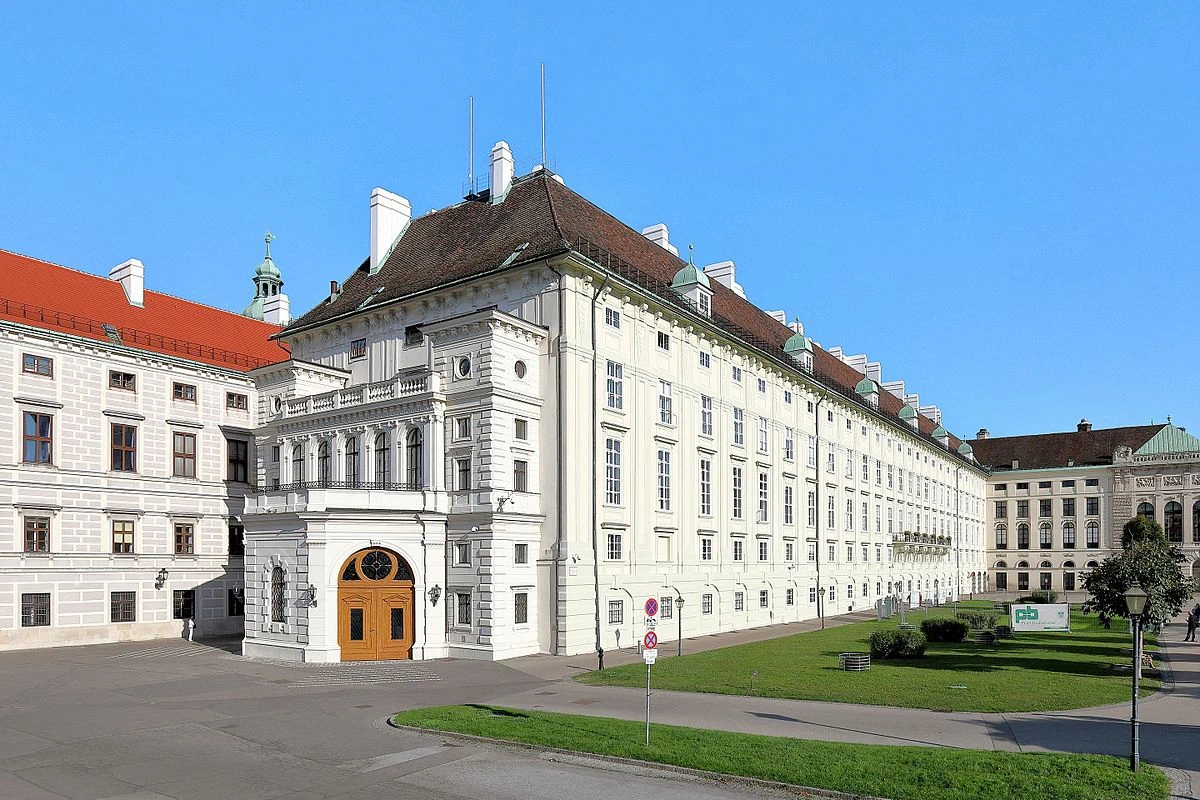
Venturing deeper into the wing reveals the Privy Council Room, a chamber steeped in imperial history. It was here that Emperor Franz Joseph I inaugurated the Austro-Hungarian Delegation's sessions with his speeches. In a corner of this room, under the weight of dynastic continuity, Archduke Franz Ferdinand, the emperor's nephew and successor, pronounced the Oath of Renunciation on the 28th of June, 1900. This solemn vow stripped his future offspring of any claim to the throne, a sacrifice made in the name of love, as his marriage was deemed morganatic due to his fiancée's lower social standing.
Beneath the grandeur of the Leopoldine Wing and the Amalienburg lies a vast expanse once dedicated to the imperial wine cellar. This subterranean vault, a testament to the opulence of the Hofburg Palace, once housed an extensive collection of fine wines, serving as a liquid history of the empire's tastes and celebrations.
Imperial Chancellery Wing of Hofburg Palace
In the early 18th century, the vision of Emperor Charles VI gave rise to the construction of the Imperial Chancellory Wing, a masterpiece that would later house generations of his lineage. The architectural genius behind its inception was Johann Lukas Hildebrandt, who, in 1723, laid down its foundational stones. However, the tides of fate soon demanded a change in hands, and Joseph Emanuel Fischer von Erlach, a contemporary rival of Hildebrandt, took the reins, bringing the construction to its completion in 1730. This wing, the latest addition to the four enclosing the Innerer Burghof, became the cradle of power for the Holy Roman Empire.
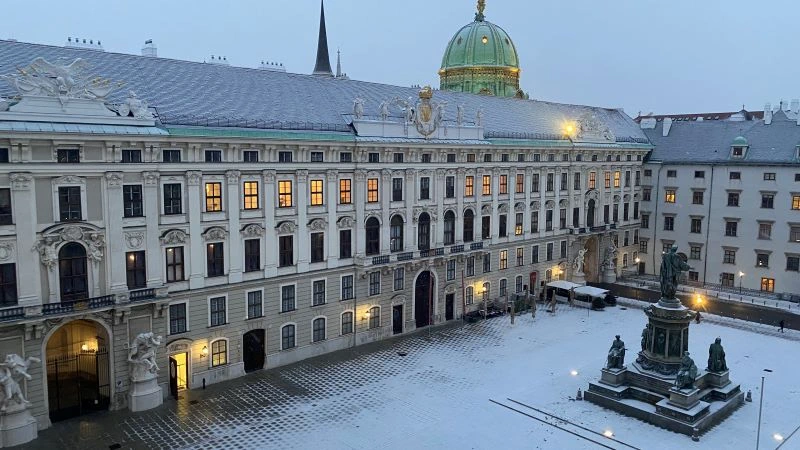
Initially, Emperor Charles VI himself inhabited this architectural marvel, conducting the empire's affairs within its walls. Yet, it was his daughter, Maria Theresa, who, upon her ascension, showed a preference for the Leopold Wing, signaling a shift in the royal quarters. After the emperor's demise in 1740, the Chancellory Wing assumed a new role as the seat of the empire's supreme authority.
The dissolution of the Roman-German Empire in 1806, under Hapsburg Franz II, transformed the wing once more, this time into a residential space for the imperial family. Mid-19th century saw Emperor Franz Joseph I, alongside Empress Elisabeth of Austria and their progeny, settling into the wing, making it their home. The Emperor's work and rest were confined to these quarters, while Elisabeth preferred the adjacent Amalienburg for her residence.
The facade of the Imperial Chancellory Wing, facing the inner castle courtyard, stands as a testament to architectural elegance, boasting three portals topped with balconies and an intricate arrangement of figures at the attic level. Despite its completion in the early 1730s, its design subtly nods to the nascent Classicist style that would soon take precedence in architectural trends.
A notable feature, the Kaisertor, served as an exclusive passage for the imperial family, adorned with the coat of arms of Emperor Charles VI and the Roman-German Imperial Crown, signifying the imperial dignity and its chivalric traditions, notably the Order of the Golden Fleece.
Adorning the side portals, sculptures by Lorenzo Mattielli depict the Herculean saga in sandstone, a testament to the imperial connection to heroic antiquity.
Today, the Imperial Chancellory Wing opens its doors to the public, allowing a glimpse into the lives of Emperor Franz Joseph and Empress Elisabeth through the Imperial Apartments, now part of a museum that also includes the Imperial Silver Collection and Sisi Museum, all accessible under the majestic dome of St. Michael's Wing.
The Court Library
Nestled on the opposite side of a grand Hofburg Palace complex, the Court Library, originally an independent edifice, has found its home. It was Charles VI's vision that led to the creation of the main structure and the majestic Prunksaal hall. Presently, it resides under the protective wing of the Austrian National Library, a testament to its historical and cultural significance.
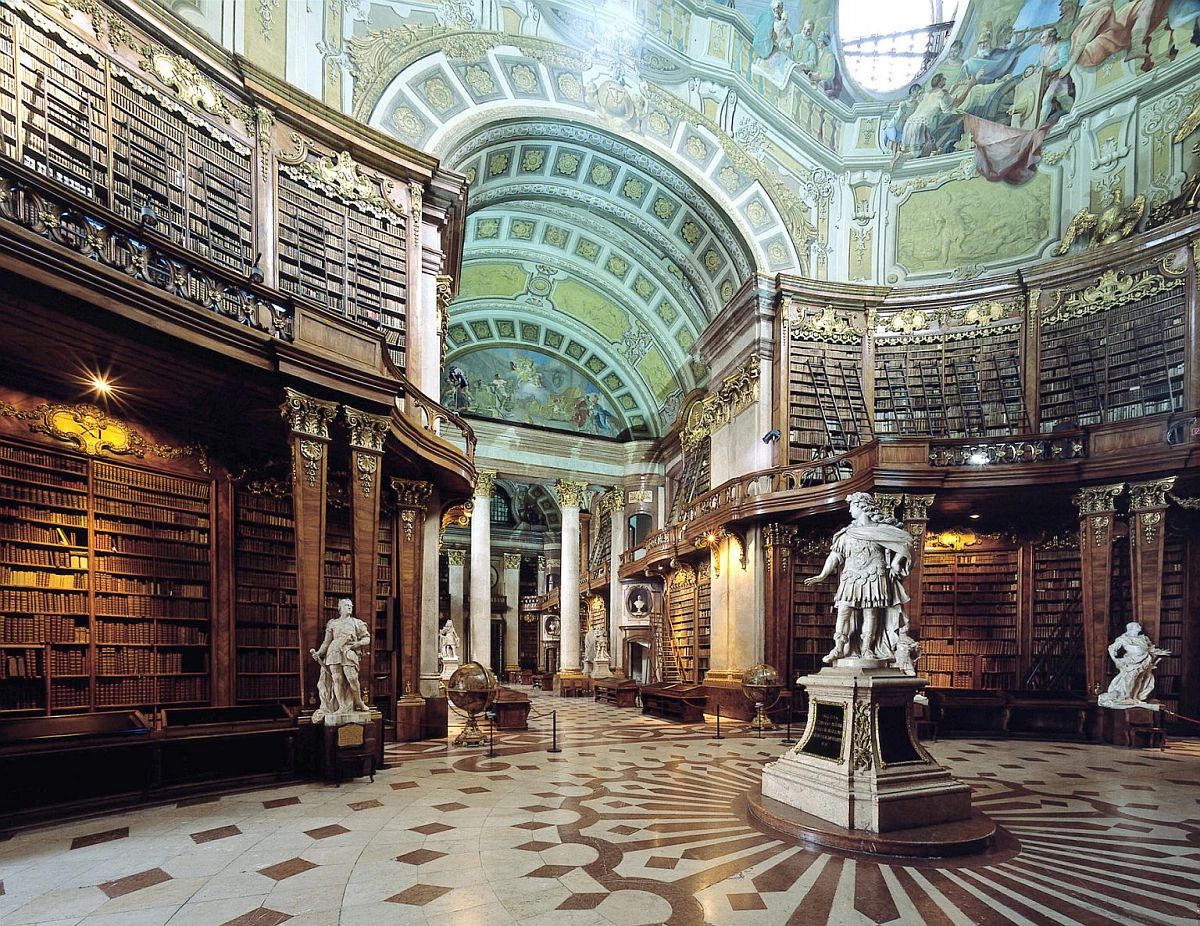
The library's foundation was laid by the esteemed Johann Bernhard Fischer von Erlach, with the baton passed to his son, Joseph Emanuel, who completed this architectural masterpiece in 1735. Stepping into the Prunksaal, one is greeted by the intellectual legacy of Prince Eugene of Savoy, encapsulated within its vast book collection. The hall's ceiling is adorned with an expansive fresco by Daniel Gran, while statues of emperors crafted by Paul Strudel imbue the space with a sense of grandeur and historical depth. Lorenzo Mattielli's touch graces the exterior with attic style figures, culminating in 1726 with Athena's dynamic figure atop a quadriga over the main entrance.
The roof's narrative continues with Atlas, burdened yet steadfast, holding the celestial globe, amid representations of Astronomy and Astrology. On the diametric opposite, Gaia presents the terrestrial globe, with Geometry and Geography standing guard. This library, a beacon of knowledge and art, stands proudly at Joseph Square, to the north.
Augustinian Wing
Nestled on the south-eastern verge of Joseph Square, the Augustinian Wing unfurls its baroque splendor, housing both a church and monastery. Its foundation predates the neighboring Court Library, gradually weaving itself into the fabric of the palace's expansion.
The hallowed halls of the Augustinian Church have witnessed the sacred union of Habsburg royalty, notably serving as the backdrop for Emperor Franz Joseph I's marriage to Empress Elisabeth, affectionately known as Sisi.
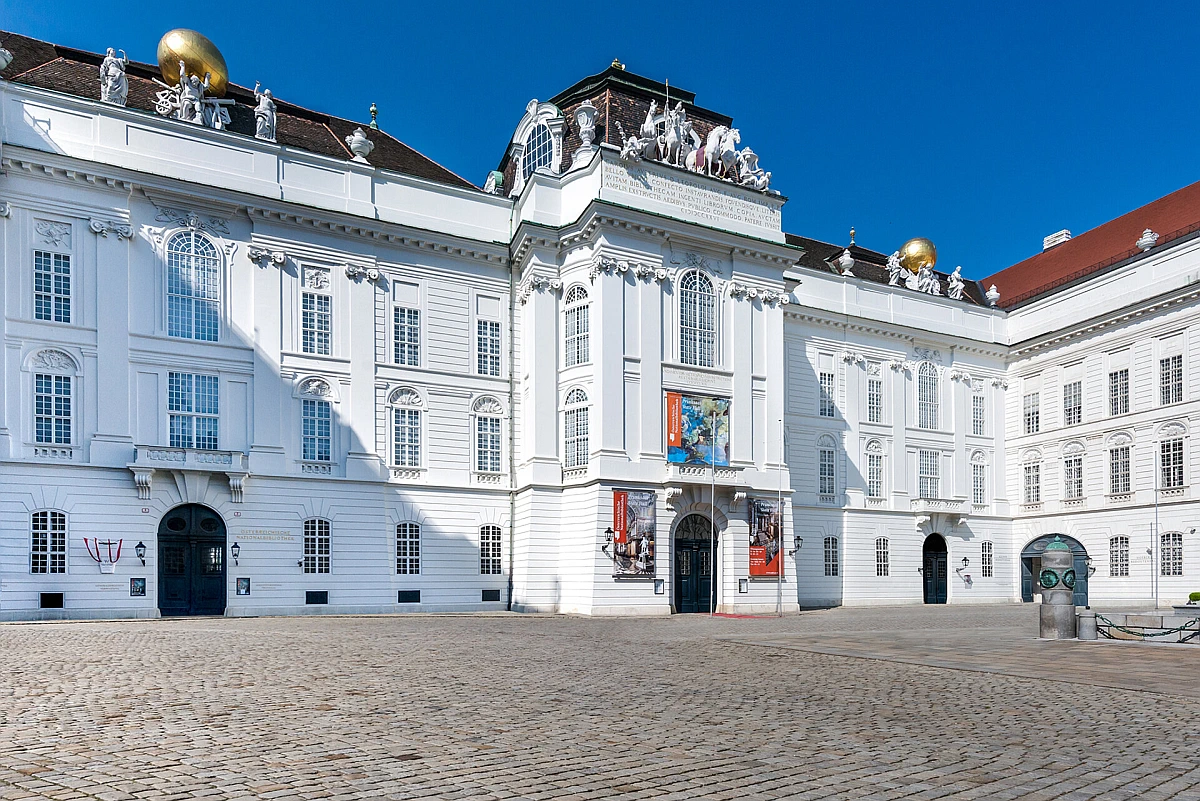
Tucked behind the Loreto side chapel, the Hearts' Crypt harbors a unique legacy. Enclosed by an iron barrier, this semicircular vault cradles the hearts of 54 Habsburgs, each resting in silver urns.
A stone's throw away, the Palais Archduke Albrecht, now housing the renowned Albertina museum, melds with the Hofburg's legacy through its architectural synergy with the Augustinian monastery. Initially a noble residence in the early 19th century, it was later intricately linked to the Hofburg, especially after its transformation under Joseph Kornhäusel's keen eye in the 1820s. This blend of history and architecture encapsulates the essence of a bygone era, where the echoes of imperial footsteps still resonate.
Festival Hall Wing
The Hofburg Palace in Vienna, is a sprawling complex with a rich history reflected in its varied architecture and the stories of its many halls. Among these, the Marble Hall and the Hall of Ceremonies are particularly notable for their historical and architectural significance, alongside the grand Hall of Festivals (Festsaal), each telling a unique part of the palace's imperial past.
The Marble Hall, initially part of the 16th-century Leopoldine Wing, underwent an interior transformation around 1840. The scagliola technique was employed to give it an appearance consistent with the adjacent, newer Hall of Ceremonies. During the imperial era, it was repurposed for dining and hosting balls specifically for children at court, showcasing the hall's versatility and importance in court life.
The Hall of Ceremonies, crafted at the dawn of the 19th century by Belgian architect Louis Montoyer for Emperor Francis II/I, presents an interesting architectural protrusion from the Leopoldine Wing, affectionately dubbed the "Nose" due to its distinct shape. This hall, adorned with a magnificent coffered ceiling, 26 crystal chandeliers capable of holding 1,300 candles, and 24 Corinthian columns fashioned from scagliola to mimic marble, is steeped in historical significance. It served as a backdrop for significant events, including Napoleon I's proposal to Archduchess Marie Louise and various imperial court balls. The inclusion of a traditional Maundy ceremony on Maundy Thursday further underscores the hall's ceremonial importance.
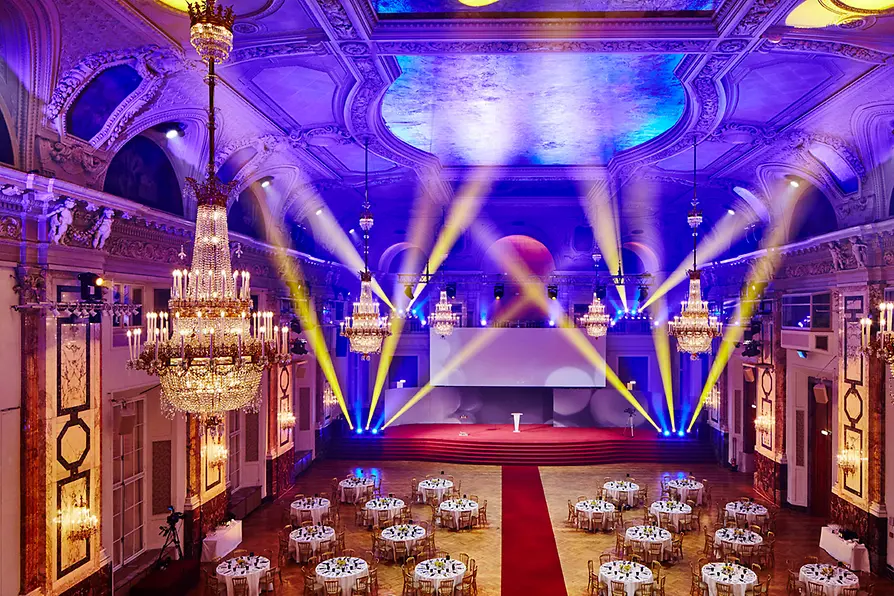
By 1916, the Hall of Ceremonies was seamlessly integrated into the Neue Burg section of the Hofburg, reflecting the continuous evolution of the palace's structure and its adaptation to the needs of its royal inhabitants.
The Hall of Festivals, the largest within the Hofburg with a floor space of 1,000m², represents the zenith of the palace's grandeur. Although originally intended as a throne room, it never served this purpose. Completed in 1923, its interior is adorned with ceiling paintings by Alois Hans Schramm and side panel paintings by Eduard Veith and Viktor Stauffer, celebrating the glory of the Habsburg dynasty. The hall's significant role in hosting the 1967 Eurovision Song Contest illustrates its continued use for prominent events beyond the imperial era.
Together, these halls embody the historical layers, architectural beauty, and cultural significance of the Hofburg Palace, serving as a testament to the rich imperial history of Austria.
Stallburg
Standing as a testament to a blend of architectural marvel and historical stratagem in the Hofburg Palace, the Stallburg, detached yet an integral part of the Hofburg complex, emerged as the domicile for Maximilian, the then crown prince. Legend whispers of Ferdinand I's reluctance to share his abode with Maximilian, propelled by the latter's leanings towards Protestantism.
As time wove its narratives, this edifice embraced the artistic treasures of Archduke Leopold Wilhelm, a patron of the arts and sibling to Emperor Ferdinand III. These collected masterpieces laid the cornerstone for what would burgeon into the illustrious Kunsthistorisches Museum in 1889. Morphing through the Baroque period, the structure underwent a transformation, dedicating its ground level to the imperial equines, a legacy that the Spanish Riding School (Spanische Hofreitschule) upholds to this day (see later).
St. Michael's Wing in Hofburg Palace
In the grand blueprint of the Hofburg Palace, the concept for St. Michael's Wing was originally brought to life by the visionary Joseph Emanuel Fischer von Erlach. This segment was envisioned as a bridge, linking the Winter Riding School with the Imperial Chancellery Wing. Yet, an architectural obstacle stood in its path—the ancient Imperial Court Theatre (Burgtheater), which delayed its realization. It wasn't until Ferdinand Kirschner reimagined Erlach's vision and, from 1889 to 1893, brought the wing to life with minor modifications to the original plan.
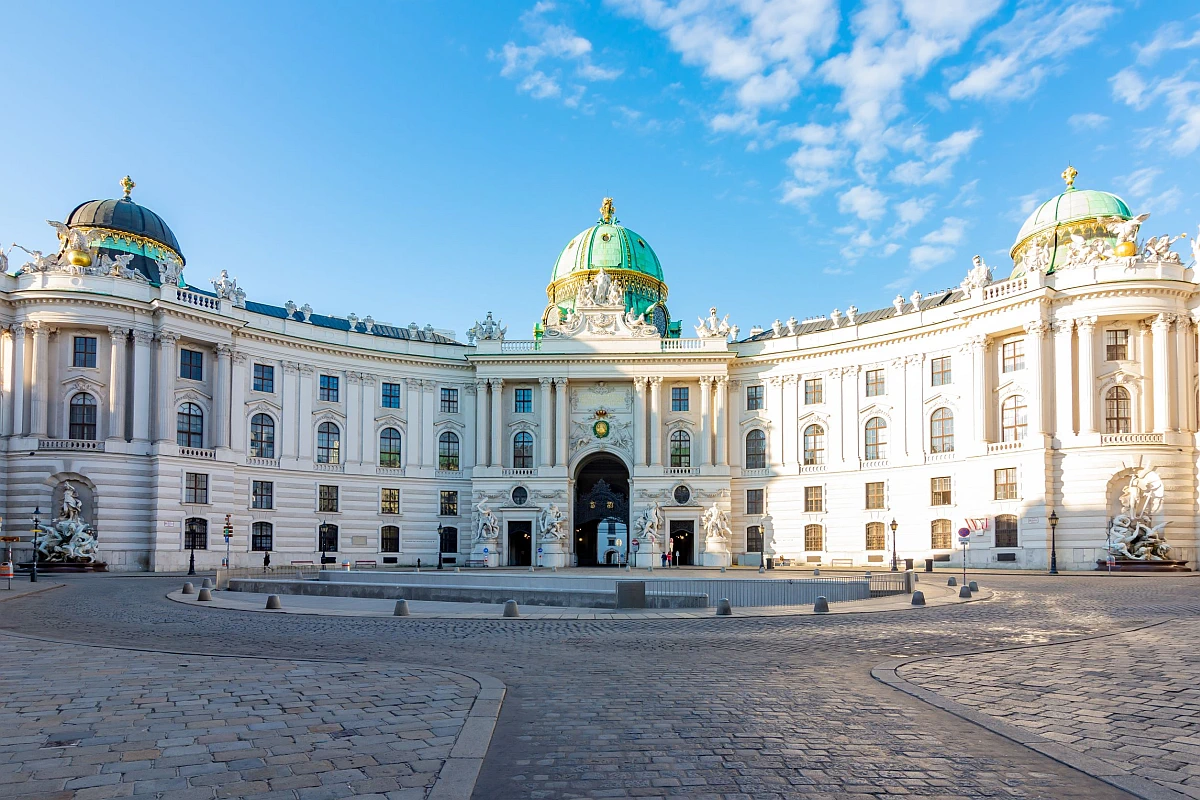
Upon the unveiling of St. Michael's Square, it was adorned with two majestic sculpted fountains that graced the wing's façade. One, titled "Power at Sea," was the masterpiece of Rudolf Weyr, while the other, "Power on Land," was sculpted by the skilled hands of Edmund Hellmer.
The naming of the wing pays homage to St. Michael's Church, standing proudly across from it, a silent guardian watching over the square.
Hofburg Palace: A Seat of Power and Politics
Hofburg Palace's role in European history cannot be overstated. It has been the locus of power for the Habsburg dynasty, witnessing critical decisions that shaped the continent's destiny. The palace's political significance remains undiminished, serving as a venue for international diplomatic events and as the office of the Austrian President, thus continuing its legacy as a center of political discourse.
Throughout the ages, Hofburg Palace has expanded under the influence of various Habsburg monarchs, each contributing their unique architectural styles, from Gothic to Renaissance, Baroque to Rococo, making the palace a living museum of architectural history.
As a seat of power and politics, Hofburg Palace has witnessed significant historical events that have shaped not only Austria but also the trajectory of European history. It served as the imperial winter residence, with the Habsburgs ruling vast swathes of Europe from these very halls. Today, it continues to play a pivotal role in Austrian political life, housing the official residence and offices of the President of Austria, along with important government and state functions. The palace complex includes the Austrian National Library, the Imperial Treasury holding the imperial crowns, and the Burgkapelle, home to the Vienna Boys' Choir.
The allure of Hofburg Palace extends beyond its political significance. It is a cultural hub, drawing visitors from around the globe to marvel at its architectural grandeur and its collections of art, armor, and imperial artifacts. The palace's Spanish Riding School, with its world-famous Lipizzaner horses, offers a glimpse into the traditions and customs that have been preserved over centuries. Hofburg Palace thus remains a symbol of the enduring legacy of the Austrian monarchy, its role in European politics, and its contribution to the cultural and historical heritage of Vienna.
Sisi Musem inside the Hofburg Palace
The Sisi Museum in Vienna offers a unique and in-depth exploration into the life of Empress Elisabeth of Austria, affectionately known as "Sisi." Situated in the Imperial Apartments of the Imperial Palace, the museum diverges from typical portrayals, shedding light on the real person behind the myth. It provides a comprehensive view of Sisi's life, focusing on her private endeavors, her defiance against courtly formalities, her obsession with beauty and physical fitness, her love for travel, and her passion for poetry. The narrative spans from her carefree youth in Bavaria to her unexpected engagement to the Austrian emperor, culminating in her tragic assassination in Geneva in 1898.
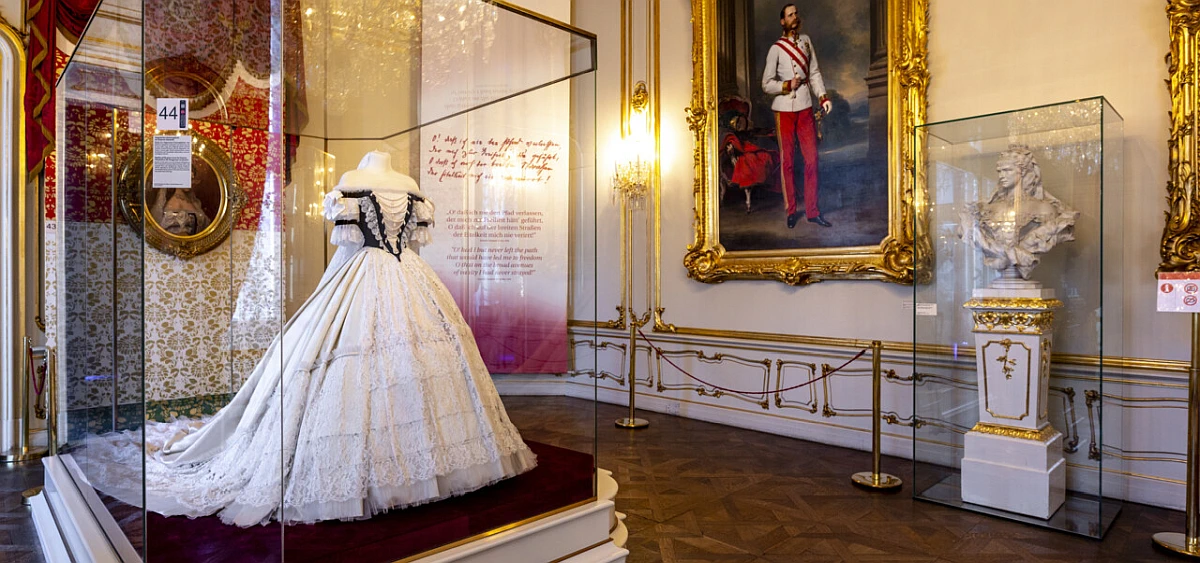
The museum houses over 300 personal artifacts that belonged to Elisabeth, offering visitors an intimate glimpse into the empress's life. These include her original clothing, a miniature secretaire adorned with her own paintings on envelopes, her watercolor painting box, and a 63-piece first-aid kit. A particularly remarkable exhibit is the accessible reconstruction of Elisabeth's imperial saloon car, providing a taste of her luxurious lifestyle.
Among the standout pieces are the replicas of her wedding eve dress, the Hungarian coronation robes, and the 6-piece mourning jewelry set in onyx and jet, worn in grief over her son Crown Prince Rudolph's death. Additionally, the museum displays Elisabeth's childhood harp, which she brought from Bavaria, symbolizing her personal history and heritage.
A poignant exhibit is the death mask of Empress Elisabeth, alongside the black coat adorned with egret feathers she wore after her assassination. This garment, which she was covered with when taken to the Hotel Beau Rivage on Lake Geneva, features egret feather trimmings, and its silk lining is embroidered with her crowned name, encapsulating both her elegance and the tragedy of her end.
The Sisi Museum not only commemorates Empress Elisabeth's life but also challenges the myths, offering a balanced view of her complex character and her restless, often misunderstood existence. Through its extensive collection, the museum invites visitors to understand the depth of Sisi's personality and the realities of her life beyond the facade of imperial grandeur.
In the Silver Collection magnificent dining services, centrepieces measuring up to 30 metres in length and exquisite napery give an impression of the lavish pomp of imperial banquets.
Art and Culture at Hofburg Palace
Hofburg Palace stands as a beacon of artistic and cultural heritage in the heart of Vienna. This historic palace complex has evolved over centuries, embodying the cultural and political heart of the Habsburg dynasty. Its grandeur and architectural elegance are matched only by the richness of its contents, making Hofburg Palace a pivotal destination for those seeking to immerse themselves in the depths of art and history.
Within its expansive confines, the palace harbors some of the world's most prestigious collections, ranging from the opulent artifacts of the Secular and Ecclesiastical Treasuries to the exquisite works housed in the Albertina Museum. Each collection offers a unique narrative, capturing the essence of various epochs and artistic movements.

The allure of Hofburg Palace is not limited to its historical significance; it is a living museum, where every corridor, hall, and gallery speaks volumes of the artistic endeavors of humanity. The Secular and Ecclesiastical Treasuries, for instance, present a dazzling array of imperial regalia, relics, and ornaments that reflect the power and prestige of the Habsburg monarchs. These treasures, some of which date back to the Holy Roman Empire, provide insight into the secular and spiritual lives of Europe's ruling elites.
Meanwhile, the Albertina Museum, seamlessly integrated into the palace complex, showcases a vast collection of prints, drawings, and paintings by some of the most renowned artists from various periods and styles. From classical masterpieces to contemporary works, the museum offers a comprehensive journey through the world of art, making Hofburg Palace an essential stop for art aficionados.
Exploring Hofburg Palace is akin to traversing through time, where each room and each collection unfolds part of the human story through art and culture. The palace not only stands as a monument to the imperial legacy of Austria but also as a testament to the enduring power of art to capture, inspire, and provoke. It is a treasure trove that beckons visitors from around the globe, inviting them to delve into the captivating and diverse realms of artistic expression.
Whether one is drawn to the sacred artifacts of the treasuries or the avant-garde pieces in the Albertina, Hofburg Palace offers a rich tapestry of human creativity waiting to be discovered.
Imperial Apartments and Their Stories
The Imperial Apartments housed within the magnificent Hofburg Palace stand as a testament to the opulence and complex history of the Habsburg monarchy. These rooms, adorned with luxurious furnishings and detailed decorations, serve not just as a display of imperial wealth but as storytellers of the lives once lived within their walls. The Hofburg Palace, located at the heart of Vienna, Austria, has been the epicenter of Austrian political life for centuries, and the Imperial Apartments offer a unique window into the private lives of its most famous residents.

Walking through the Imperial Apartments, one can almost hear the whispers of past intrigues, the rustle of silk gowns, and the clink of fine porcelain during grand banquets. Each room, from the opulent reception halls to the intimate living quarters, is meticulously preserved, allowing visitors to immerse themselves in the daily experiences, romantic entanglements, and complex personal stories of the Habsburgs. The Hofburg Palace, with its Imperial Apartments, thus provides a fascinating narrative of how the imperial family's public duties intersected with their private lives, highlighting their human aspects against the backdrop of their regal responsibilities.
The allure of the Imperial Apartments lies not only in their aesthetic beauty but in the stories they preserve. These narratives, encapsulated in every artifact and painting, provide a deeper understanding of the cultural and political landscape of the era. Visitors to the Hofburg Palace leave with a profound appreciation for the historical significance of the Habsburg dynasty and the intricate tapestry of European history woven through the lives of its rulers. The Imperial Apartments, therefore, stand as a monument to the legacy of the Habsburg monarchy, inviting all who visit to step back in time and explore the grandeur and complexities of imperial life.
Gardens and Outer Realms: A Breath of Fresh Air
Gardens and outer realms serve as tranquil sanctuaries amidst the urban landscapes, and nowhere is this more evident than in the lush expanses surrounding Hofburg Palace. These gardens, including the Burggarten, Volksgarten, and the expansive Heldenplatz, offer a breath of fresh air to those seeking solace from the city's relentless pace.
The Burggarten, with its meticulously manicured lawns and vibrant flowerbeds, provides a picturesque backdrop for leisurely strolls or quiet contemplation. The Volksgarten, known for its enchanting rose garden featuring over 3,000 rose bushes of different varieties, is a favorite among locals and tourists alike. It's a place where the fragrance of blooming roses fills the air, creating a romantic atmosphere that's hard to find elsewhere. Meanwhile, the Heldenplatz, with its open spaces and historic monuments, stands as a powerful reminder of Austria's storied past, offering a space for reflection amidst the city's bustling activity.

The gardens and outer realms of Hofburg Palace are more than just areas of natural beauty; they are spaces where history and tranquility converge. Visitors to these gardens can wander through paths flanked by historical statues and memorials, each telling its own story of Austria's heritage. In the midst of Vienna's urban environment, the Hofburg Palace and its surrounding gardens offer a peaceful retreat, inviting those who walk their grounds to pause and appreciate the beauty and history intertwined within their landscapes. Whether it's admiring the floral displays of the Volksgarten or reflecting on the historical significance of the Heldenplatz, a visit to the gardens of Hofburg Palace is truly a breath of fresh air.
Hofburg Palace: A Center of Equestrian Excellence
Hofburg Palace is not only a historic architectural marvel but also a globally recognized center of equestrian excellence. This prestigious palace is home to the Spanish Riding School, an institution that has become synonymous with the highest standards of classical dressage. The school is famed for its association with the Lipizzaner horses, a breed known for their intelligence, agility, and ability to perform complex maneuvers that have been refined and perfected over centuries.
The Spanish Riding School, situated within the expansive grounds of Hofburg Palace, stands as a living testament to Europe's rich equestrian heritage. It offers visitors an unparalleled spectacle, showcasing the grace and power of the Lipizzaner horses through performances that highlight the beauty of classical dressage. These performances are the result of rigorous training and a deep bond between the riders and their horses, embodying a tradition that has been meticulously preserved since the Renaissance.

Hofburg Palace, through the Spanish Riding School, continues to be a beacon of equestrian excellence, attracting enthusiasts and tourists from around the world. The school not only serves as a reminder of the historical significance of horseback riding in European culture but also plays a crucial role in preserving the techniques and artistry of classical dressage for future generations. In this way, Hofburg Palace remains a pivotal institution in the equestrian world, where the legacy of the Lipizzaner horses and the timeless elegance of dressage are celebrated and perpetuated.
Tips and Tricks for visiting Hofburg Palace
Visiting the Hofburg Palace in Vienna is a journey through centuries of European history, art, and culture. The Hofburg has been the seat of power for various empires and republics since 1279, and today it houses several significant museums, the Austrian National Library, and the office of the President of Austria. When planning your visit, incorporating the Vienna Pass can make your experience smoother and more enjoyable. Here are some tips and tricks to help you get the most out of your visit:
- Pre-Purchase the Vienna Pass: Maximize Your Savings: The Vienna Pass offers free entry to over 60 attractions, including the Hofburg Palace. It comes in 1, 2, 3, or 6 consecutive day options. Assess your itinerary to choose the best duration for your visit.
Fast Track Entry: For many attractions, including the Hofburg, the Vienna Pass provides fast-track entry, allowing you to skip the lines. This can save you a lot of time, especially during peak tourist seasons. - Utilize the Vienna Pass App: Download the Vienna Pass mobile app for up-to-date information on attractions, maps, and opening hours. It can help you plan your day efficiently. The app also offers suggested routes. These can help you discover nearby attractions covered by the Vienna Pass, optimizing your sightseeing schedule.
- Visit During Off-Peak Hours: To avoid crowds, try to visit early in the morning or later in the afternoon. The palace is less crowded on weekdays.
- Imperial Treasury (Schatzkammer): With the Vienna Pass, gain access to the Imperial Treasury to see the imperial crown, orb, and sceptre, among other treasures.
- Spanish Riding School: Plan to see a morning exercise or a guided tour of the Spanish Riding School, which is part of the Hofburg complex. Some Vienna Pass options offer discounts on performances and tours.
- Audio Guides and guided tours: The Hofburg Palace's audio guide is included with your ticket. Make sure to utilize it for a more informative and immersive experience. Some Vienna Pass options may include special guided tours. These can offer deeper insights into the history and architecture of the Hofburg Palace.
- Cafés and Restaurants: The Hofburg area is home to several historic cafés and restaurants. Use these opportunities to rest and sample traditional Viennese cuisine, such as Sachertorte or Wiener Schnitzel.
- Convenience: Staying in a hotel close to the Hofburg Palace can save you time and make your visit more relaxed. You'll have the flexibility to visit the palace over multiple days if you wish, without the need to commute far.
- Relax and Enjoy: The Hofburg is surrounded by beautiful gardens and parks, such as the Burggarten and Volksgarten. Take some time to relax and enjoy these green spaces.
FAQs about Hofburg Palace
What is Hofburg Palace?
Hofburg Palace is a historic palace located in Vienna, Austria. It served as the imperial palace of the Habsburg dynasty rulers and today houses the office of the President of Austria, as well as several museums, and historic rooms open to the public.
Where is Hofburg Palace located?
Hofburg Palace is located in the center of Vienna, Austria. The exact address is Hofburg, 1010 Wien, Austria.
When was Hofburg Palace built?
The Hofburg Palace has a long history, with its origins dating back to the 13th century. However, it has undergone numerous expansions and renovations over the centuries, with significant contributions from various Habsburg emperors.
Can visitors tour Hofburg Palace?
Yes, visitors can tour Hofburg Palace. The palace is open to the public and offers various tours that include the Imperial Apartments, the Sisi Museum, and the Silver Collection. There are also special exhibitions held throughout the year.
What are the opening hours of Hofburg Palace?
The opening hours of Hofburg Palace can vary depending on the season and the specific attractions within the palace. Generally, it is open daily, but it is advisable to check the official website for the most accurate and up-to-date information.
What attractions can be found inside Hofburg Palace?
Hofburg Palace is home to several attractions, including the Imperial Apartments, the Sisi Museum, the Silver Collection, the Austrian National Library, and the Imperial Chapel (Hofkapelle). There are also various temporary exhibitions and events throughout the year.
How much does it cost to visit Hofburg Palace?
The admission fee for Hofburg Palace varies depending on the attractions you wish to visit and any combined tickets you may purchase. There are different tickets for the Imperial Apartments, Sisi Museum, and Silver Collection, as well as combined tickets. Discounts are available for children, students, and seniors. For the most current pricing, please check the official website.
Is there a dress code for visiting Hofburg Palace?
There is no formal dress code for visiting Hofburg Palace, but visitors are encouraged to dress respectfully, as it is a historic and cultural site.
How can I get to Hofburg Palace?
Hofburg Palace is accessible by public transportation, including the Vienna metro (U-Bahn), buses, and trams. The closest metro stations are Herrengasse (U3) and Museumsquartier (U2). Several bus and tram lines also stop near the palace.
Are there guided tours available at Hofburg Palace?
Yes, Hofburg Palace offers guided tours in several languages, providing insights into the history, architecture, and significance of the palace and its collections. Information on tour schedules and languages can be found on the official website.
Is Photography Allowed Inside The Hofburg Palace And The Sisi Museum?
Yes, photography is allowed inside the Hofburg Palace and the Sisi Museum. However, there may be certain tour restrictions for Hofburg Palace and Sisi Museum, so it’s best to check with the tour guide.
Conclusion
Hofburg Palace is more than just a historic landmark; it's a living testament to the rich tapestry of European history, culture, and art. As a time capsule of opulence, power, and art, it continues to fascinate and inspire visitors from around the world, offering a unique window into the past and a vision for the future.
Site location: Museumsplatz 1, 1070 Wien (CONTIPARK MuseumsQuartier garage)
GPS coordinates: 48.204023, 16.359352
Google Photos: Click here
Did you find our article interesting? We have good news, as we will be constantly updating the content on our website. If you want to know all about Europe's big cities, follow our column by clicking here!















